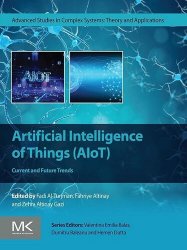 Название
Название: Artificial Intelligence of Things (AIoT): Current and Future Trends
Автор: Fadi Al-Turjman, Fahriye Altinay, Zehra Altinay Gazi
Издательство: Morgan Kaufmann/Elsevier
Год: 2025
Страниц: 350
Язык: английский
Формат: epub
Размер: 12.0 MB
Artificial Intelligence of Things (AIoT): Current and Future Trends brings together researchers and developers from a wide range of domains to share ideas on how to implement technical advances, create application areas for intelligent systems, and how to develop new services and smart devices connected to the Internet. Section One covers AIoT in Everything, providing a wide range of applications for AIoT methods and technologies. Section Two gives readers comprehensive guidance on AIoT in Societal Research and Development, with practical case studies of how AIoT is impacting cultures around the world. Section Three covers the impact of AIoT in educational settings.
The book also covers new capabilities such as pervasive sensing, multimedia sensing, Machine Learning, Deep Learning, and computing power. These new areas come with various requirements in terms of reliability, quality of service, and energy efficiency.
- Provides readers with up-to-date and comprehensive information on the latest advancements in AIoT, including wireless technologies, pervasive sensing, multimedia sensing, Machine Learning, Deep Learning, and computing power
- Explores the possibilities of new domains, services, and business models that can be created using AIoT
- Discusses the potential impact of AIoT on society, including its potential to improve efficiency, reduce costs, and enhance quality of life
A Deep Learning technique called a convolutional neural network (CNN) is used to identify objects in images and examine their visual content. CNN uses a pooling layer to make the pixels smaller and to help find and keep the pixel patch. However, numerous real-world applications of the CNN algorithm exist, such as for both cancer screening and biometric identification. CNN may provide answers to visual queries as well as caption photos. CNN networks examine the images provided as input and generate natural-language answers to the visuals. CNNs have become the most efficient tool for computer vision tasks due to their superior efficiency for both video and image data. Millions of neurons are used in CNNs, which are biologically inspired and designed to learn invariant features. CNNs have weight parameters in width, height, and depth as opposed to standard neural networks, which enable the network’s final architecture to condense all of the image’s features into a single vector. The most popular Deep Learning architecture for computer vision is built using a variety of CNN-based Deep Learning models that have been demonstrated to work well on image datasets like ImageNet. Face recognition is the program that is most frequently used. Moreover, a comprehensive CNN’s architecture typically consists of three main types of layers: “A full CNN’s architecture is composed of three primary types of layers: convolutional, pooling and fully connected.” The spatial information of the input image is preserved using a linear transformation known as a convolution layer. Each neuron would compute a transformation function between its weights and a small location in the input volume to evaluate the outcomes of neurons that are linked to specific regions for the inputs.
Promising results have been observed using Deep Learning in several challenging problem areas. Conversely, recent developments in deep learning have been utilized to create software that jeopardizes national security and individual confidentiality. One such technique is deepfakes, which creates fake photos and videos that are difficult to spot as forgeries. World leaders’ fake remarks have the potential to endanger peace and stability in the world. Deepfakes have beneficial uses as well as hazardous ones, such as in postproduction or language translation for motion pictures. Historically, 3D models and computer graphics were used for this task. But advances in computer vision and Deep Learning, especially with GANs, are replacing previous techniques with Deep Learning techniques. This technique aims to generate altered faces in images and movies with deep neural networks. An innovative design for creating a whole video sequence from a source image and a destination video is proposed in this chapter. In this work, we provide DenseNet, a motion module that uses a keypoint detector to generate dense motion, and a unified model based on LSTM-based deep neural networks. The assessment is shown using the freshly published FaceForensics++ and VoxCeleb datasets. The primary outcome of our study is the creation of novel neural networks for producing deepfake pictures and videos. Furthermore, providing datasets for deepfake identification issues is our main objective.
Readership:
Computer Science researchers, Artificial Intelligence researchers, and researchers and practitioners working in the fields of Data Science, Machine Learning, and optimization. The primary audience also includes data analysts and software engineers working with the Internet of Things (IoT).
Скачать Artificial Intelligence of Things (AIoT): Current and Future Trends
[related-news]
[/related-news]